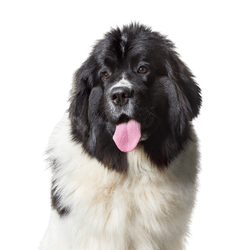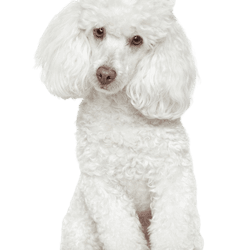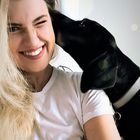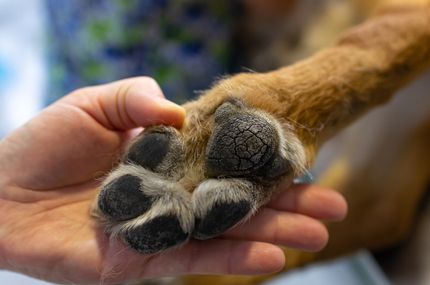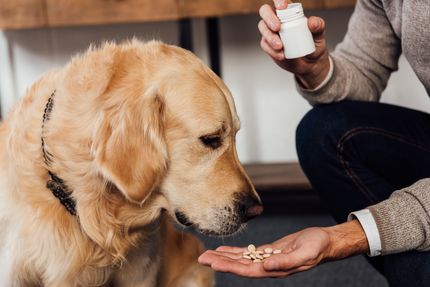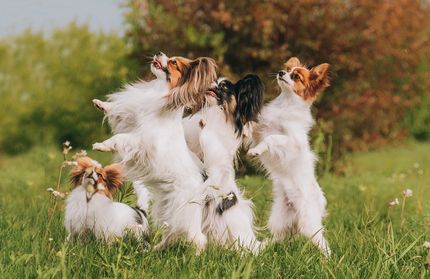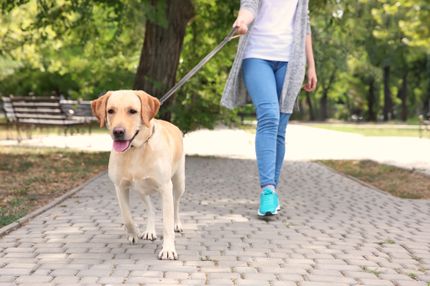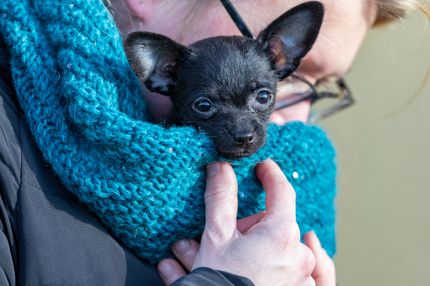Facts & Origin
Newfoundland and poodle in one
The Newfypoo is a hybrid breed that was created by crossing a Newfoundland with a poodle. The aim of this mixture was to combine the imposing appearance and friendly nature of the Newfoundland with the intelligence, elegance and often allergy-friendly coat structure of the poodle.
Targeted breeding probably began in North America as part of the growing trend to create so-called "doodles" - i.e. mixtures of poodles and other established breeds in order to combine certain characteristics. With the Newfypoo, the main aim was to create a large, family-friendly dog that could be somewhat easier to care for than the pure Newfoundland.
Name synonyms for the Newfypoo
Depending on the region and breeder, there are different spellings and synonyms for the Newfypoo. They are often referred to as Newfiedoodle, Newfypoodle or simply Newfoundland-Poodle mix. Despite minor differences, all terms refer to the same crossbreed of Poodle and Newfoundland.
Criticism of the Newfypoo
As with many designer dogs, there is also criticism of the Newfypoo. A frequent problem is the great unpredictability that is always inherent in crossbreeds without a set standard. Appearance as well as character and health risks can differ significantly from litter to litter.
The assumption that the Newfypoo is automatically easy to care for or hypoallergenic is also criticized. In reality, the coat type can vary between the parents: some Newfypoos inherit the dense, water-repellent coat of the Newfoundland, others a curlier poodle coat, and some show a mixture of both - which makes intensive coat care necessary.
In addition, both parents have their own health risks, which are not simply eliminated by crossbreeding. Anyone deciding on a Newfypoo should therefore obtain comprehensive information and ensure that the breed is reputable and health-conscious.
Suitability of the Newfypoo
Despite the points mentioned above, the Newfypoo is a wonderful companion dog if kept correctly. It often combines the gentleness and family friendliness of the Newfoundland with the intelligence and eagerness to work of the Poodle. These dogs are usually people-oriented, friendly and adaptable, but need sufficient space, exercise and mental activity to feel comfortable.
Due to their size and strength, Newfypoos are more suitable for active families or individuals with a house and garden. They are loyal companions who love closeness and activity and can grow up to be relaxed family dogs with the right training.
| Alternate Name | Newfiedoodle, Newfoundland-Poodle mix |
| Origin | Canada - Germany |
| Life expectancy | 8 - 15 years |
| Care requirements | high-maintenance |
| Activity level | average - average to high |
| FCI group | not recognised |
| AKC group | not recognised |
| KC group | not recognised |
More Newfoundland mixes
More Poodle mixes
Attitude, character and temperament of the breed
Possible character traits of the Newfypoo
The Newfypoo is usually a friendly, intelligent and even-tempered dog. They often combine the gentle, people-oriented nature of the Newfoundland with the intelligent, eager-to-learn nature of the Poodle. These dogs are often affectionate, enjoy working with their humans and display a pleasant mixture of activity and calmness.
Depending on their disposition, however, a Newfypoo can also develop a certain independence, especially if the Newfoundland part dominates. Basically, Newfypoos are affectionate, loyal and social, but need clear structures and consistent but gentle training to develop their full potential.
Character
Usage
Possible diseases of the Newfypoo
Despite the robust mixed breed disposition, health problems can occur in the Newfypoo that are inherited from both parents. These include hip and elbow dysplasia, which are a particular risk in large dogs, as well as heart problems such as dilated cardiomyopathy, which occurs in Newfoundlands.
Eye diseases such as progressive retinal atrophy (PRA) and skin problems can also occur, especially in dogs with thick coats. In addition, care should be taken to ensure controlled growth in youth to prevent joint problems in old age.
Regular veterinary check-ups, an adapted feeding and exercise program and responsible breeding decisions are crucial for a long, healthy dog life.
This is what a Newfypoo can look like
The appearance of the Newfypoo can vary greatly, but is usually somewhere between the parent breeds. As a rule, they are large, strong dogs with a shoulder height of around 60 to 75 cm and a weight of between 30 and 60 kilograms.
The coat can be either dense, wavy and high-maintenance or curly and poodle-like. Some Newfypoos have a water-repellent type of coat, others need to be trimmed or combed regularly to avoid matting.
They come in many different colors: black, brown, grey, cream, white or mixed - depending on which features are more prominent.
Overall, the Newfypoo radiates a mixture of softness, strength and elegance and often impresses not only with its size, but also with its friendly, calm appearance.
| Fur length | long - medium |
| Fur | - curly |
| Ear shape | Triangle - Floppy Ear |
| Tail | fanned out - lang |
| Anatomy | massive, hefty, slim, sporty |
| Size ♀ | 45 - 69 cm |
| Weight ♀ | 18 - 55 kg |
| Size ♂ | 45 - 74 cm |
| Weight ♂ | 18 - 70 kg |
| Suitable For | Children, suitable for allergy sufferers, Beginner, Blind people, Children, Seniors |
Known Diseases
Hip dysplasia (HD)
Hip dysplasia (HD) is a genetic condition in dogs where the hip joint is not shaped properly. This leads to pain, stiffness and restricted movement.
Gastric torsion
Gastric torsion is a disease in which the stomach rotates around its own longitudinal axis. The cause of the disease is not known.
Kidney disease
Symptoms of kidney disease in dogs: increased urination (polyuria) increased water intake. Inflammation of the mucous membrane of the mouth. Loss of appetite
Eye diseases
Often occur with allergies and intolerances.
Skin inflammations
Can be hereditary in certain breeds.
Vein diseases
Most venous diseases are of minor importance in the dog
Epilepsy
Definition: Dog has epilepsy if, for example, at least two epileptic seizures occur more than 24 hours apart.
Cataract
Cataracts are still one of the most common causes of blindness, even in dogs.
Progressive Retinal Atrophy (PRA)
Progressive retinal atrophy (PRA) is a slowly progressive death of the retina in dogs.
Patellar problems
Problems with the Patellar can be a displacement or weak kneecap, which is one of the most common causes of lameness in dogs, also because of overweight.
FAQ
-
The average size of a Newfoundland-Poodle mix is approx. 76 cm.
-
The average life expectancy of a Newfoundland-Poodle mix is between 10 and 12 years.
-
Newfoundlands and Poodle mixes can have either a smooth or curly coat. The coat is thick and dense, which helps to protect against the cold weather.
-
Newfypoos can be black, brown, cream or white.
-
Newfypoos often need a lot of grooming.
